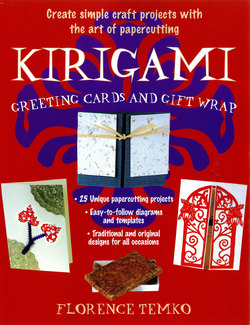Читать книгу Kirigami Greeting Cards and Gift Wrap - Florence Temko - Страница 6
На сайте Литреса книга снята с продажи.
ОглавлениеKIRIGAMI QUESTIONS AND ANSWERS
Are origami and kirigami related?
Both words are adaptations from the Japanese that have found their way into the Western vocabulary. In origami a paper square is folded into an object or animal without cutting or gluing. In kirigami paper may be cut and glued, and may sometimes be folded before cutting. Both terms include the Japanese word gami, which means "paper"; ori means "folding" and kiri means "cutting."
I popularized the word kirigami in the English language when I prepared a papercutting kit in 1962. At the time I had been practicing origami and a publisher asked me to write a book about papercutting. When it came to choosing a title, the publishing staff and I sat around debating various possibilities. I suggested kirigami and we checked with the Japanese consulate to be sure this word would be acceptable. The kit had such a wide distribution that the word kirigami became a common term.
Are special scissors needed?
Any pair of scissors that feels comfortable is suitable for most of the designs in this book, but the sharper the better. If you move on to making intricate paper cuts, you may wish to acquire a pair of small scissors with narrow blades. Because paper contains silicones, which abrade scissors in time, it is best to reserve a pair of scissors especially for papercutting, since they may lose the sharpness needed for cutting fabric.
What kinds of papers are suitable?
Almost any kind of paper can be cut successfully. When a paper has to be folded into several layers before cutting, a fairly thin weight is best, but whatever is around the house, including gift wrap, makes for a good start. Colored printing papers are next in line. Tissue paper may be more difficult to handle, but may be useful for certain projects. Origami squares colored brilliantly on the front and white on the back come in packets. Japanese handmade washi papers, decorated with glorious patterns, are sold in squares and larger sheets.
The selection of paper is one of the most important aspects of kirigami. It is appropriate to choose some more unusual papers when it comes to preparing beautiful cards. Most cities now have a paper store with an interesting selection of papers from all over the world. Otherwise catalogs may prove helpful. And do not forget to recycle papers from flyers, magazines, and correspondence.
What are some of the practical uses for kirigami?
Obviously the title of this book, Kirigami Greeting Cards and Gift Wrap, suggests two major applications, but do not overlook using paper cuts in scrapbooking, for holiday room decorations, and for gift tags. Gift tags can be smaller versions of the cutouts chosen for the gift wrapping. Any kind of handmade cards can be sold for raising funds for a good cause.
What about cards and gift wrapping?
The flat surfaces of cards, gift packages, and gift bags lend themselves to applying paper cuts, and are especially useful for mailing. It is a good idea to make a bunch of cutouts for cards or gift wrapping all at one time, ready for future birthdays or holidays.
Nowadays, when what's outside the gift seems almost as important as the gift itself, kirigami ideas can help you create unusual packaging. It may even trump the contents when a recipient treasures one of your cards enough to frame it or keep a box for storing small items.
Remember that the selection of beautiful papers will always enhance your efforts and that many designs can be placed either vertically or horizontally as the card or box demands.
Is kirigami educational?
Definitely. Whether in the classroom or art room, working on some of the projects in this book will improve students' graphic design ability, color sense, and visual acuity. Some of the projects are based on geometry and help students visualize math concepts. In social studies students can investigate paper crafts as practiced in different countries.
